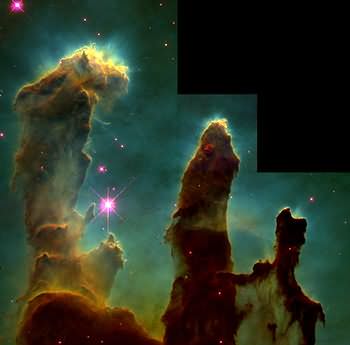I remember April 1995 very well. It was the month that the stunning and iconic image that has been called ‘Pillars of Creation’ was released. It was taken by the Hubble Space Telescope but now the James Webb Telescope is getting in on the act. Webb snapped images of the Eagle Nebula (home to the ‘pillars’) early on but now astronomers have combined the data form Hubble and Webb to create an amazing 3D animation flight through the nebula.
Continue reading “Fly Through the Pillars of Creation in this New Visualisation Made from Webb and Hubble Data”Chandra and JWST Join Forces in a Stunning Series of Images
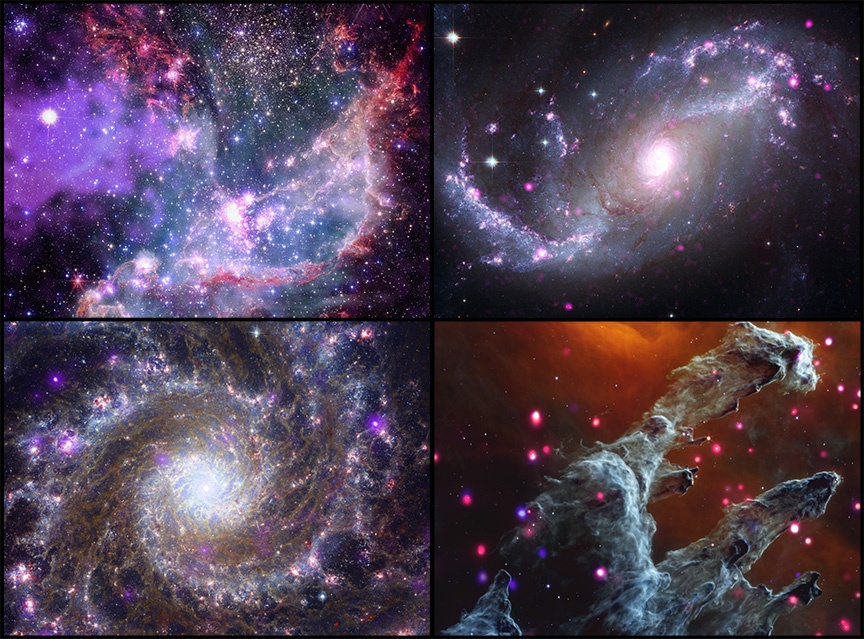
New images that combine data from NASA’s Chandra X-ray Observatory and the James Webb Space Telescope (JWST) JWST have just been released! The images feature four iconic astronomical objects, showcasing the capabilities of these observatories by combining light in the visible, infrared, and X-ray wavelengths. These include the NGC 346 star cluster located in the Small Magellanic Cloud (SMC), the NGC 1672 spiral galaxy, the Eagle Nebula (Messier 16, or M16), and the spiral galaxy Messier 74 (aka. the Phantom Galaxy).
These objects were made famous by the venerable Hubble Space Telescope, which took pictures of them between 1995 and 2005. Since it commenced operations, the JWST has conducted follow-up observations that provided a sharper view of these objects that captured additional features. Hubble and the JWST even teamed up to provide a multi-wavelength view of the Phantom Galaxy last year. By adding Chandra’s famed X-ray imaging capabilities to Webb’s sensitivity and infrared light, these latest images provide a new glimpse of these objects, revealing both faint and more energetic and powerful features.
Continue reading “Chandra and JWST Join Forces in a Stunning Series of Images”This Serpent’s Tail is Made of Starry Nebulae

The ancients didn’t have the scientific understanding of nature that we have now. All they could do was look up at the night sky and wonder, which isn’t a bad way to spend time. Part of understanding something is naming it, and when the ancients looked up at the patterns in the stars, they gave them simple names based entirely on their appearances. That’s likely how the Greeks named the constellation Serpens: it looks like a snake, so they called it that.
The Greeks lacked astronomical telescopes, so they never saw any of the rich detail in Serpens that a new image from the European Southern Observatory reveals.
Continue reading “This Serpent’s Tail is Made of Starry Nebulae”Here’s Webb’s View of the Pillars of Creation
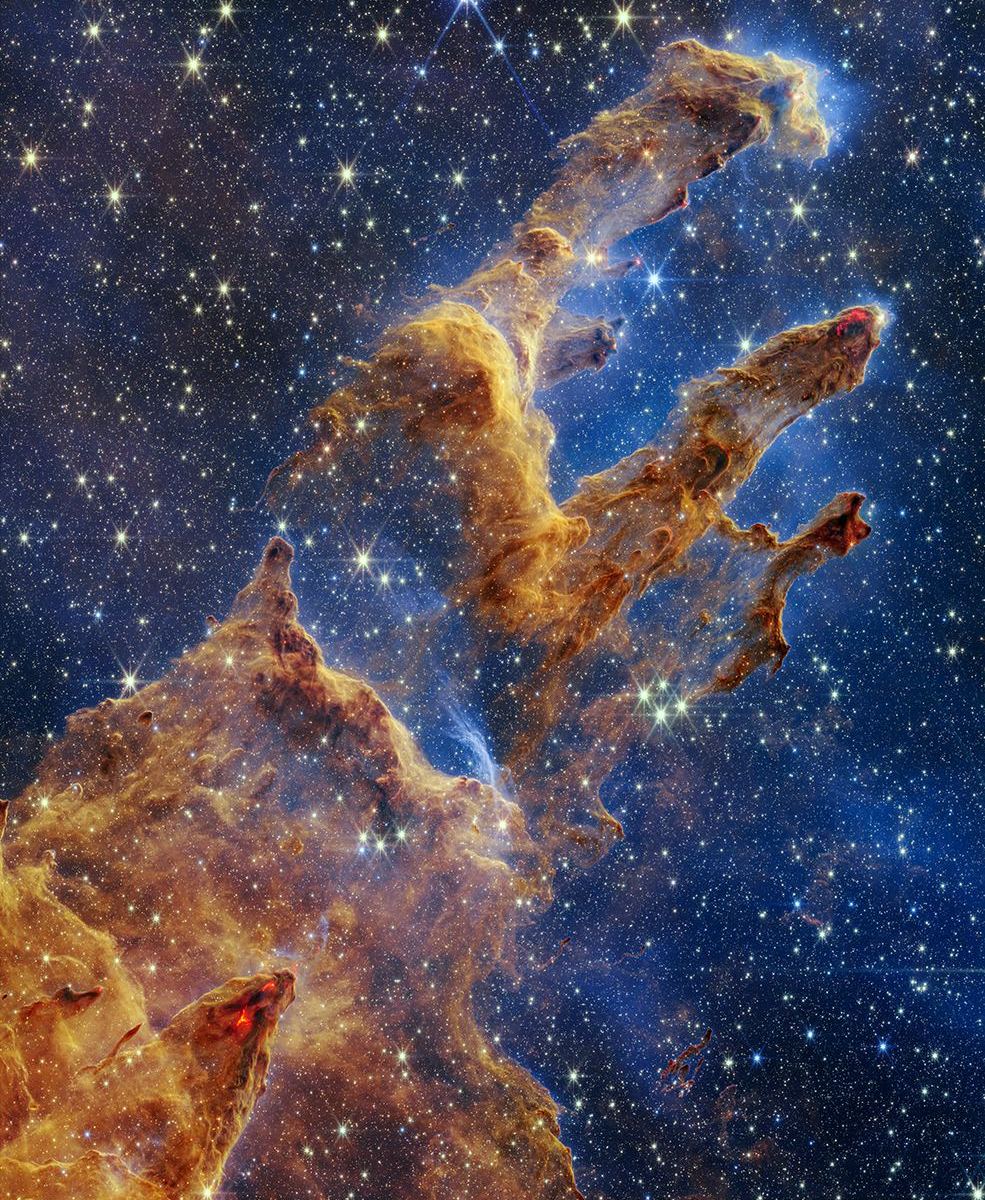
The James Webb Space Telescope is living up to expectations. When it was launched, NASA Administrator Bill Nelson said it would “… open up secrets of the universe that will be just stupendous, if not almost overwhelming.” Nelson’s statement rings true a few months into the telescope’s multi-year mission.
Continue reading “Here’s Webb’s View of the Pillars of Creation”New Hubble Image Shows Dark Cocoons Where New Stars are Forming
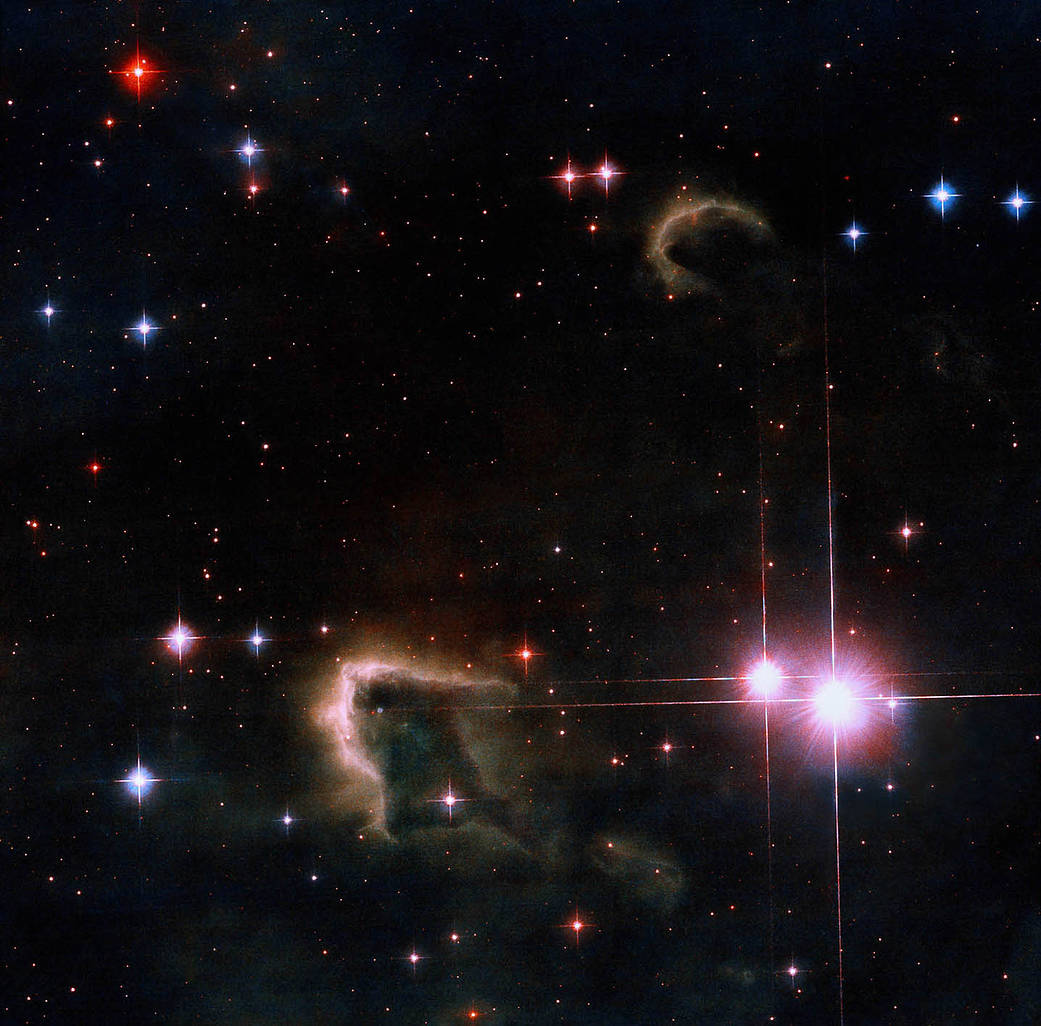
Star formation is a complex process. But in simple terms, a star forms due to clumps and instabilities in a cloud of molecular hydrogen called a Giant Molecular Cloud (GMC). As more and more gas accumulates and collapses inward, the pressure becomes immense, the gas eventually heats up to millions of degrees, and fusion begins.
But what happens to the gas that remains as the young star forms? Some of it can form a type of dark halo called a frEGG—a free-floating Evaporating Gaseous Globule. And, proving that the Universe is indeed strange, the frEGG itself can contain another stellar embryo. The frEGG can be quite opaque, making it difficult to observe the star’s formation process in all its complexity.
Continue reading “New Hubble Image Shows Dark Cocoons Where New Stars are Forming”Messier 16 (M16) – The Eagle Nebula

Welcome back to Messier Monday! In our ongoing tribute to the great Tammy Plotner, we take a look at the Messier 16 open star cluster – aka. The Eagle Nebula (and a slew of other names). Enjoy!
In the 18th century, while searching the night sky for comets, French astronomer Charles Messier began noticing a series of “nebulous objects” in the night sky. Hoping to ensure that other astronomers did not make the same mistake, he began compiling a list of these objects,. Known to posterity as the Messier Catalog, this list has come to be one of the most important milestones in the research of Deep Sky objects.
One of these objects it he Eagle Nebula (aka. NGC 661. The Star Queen Nebula and The Spire), a young open cluster of stars located in the Serpens constellation. The names “Eagle” and “Star Queen” refer to visual impressions of the dark silhouette near the center of the nebula. The nebula contains several active star-forming gas and dust regions, which includes the now-famous “Pillars of Creation“.
Description:
Located some 7,000 light years away in the next inner spiral arm of the Milky Way galaxy, the Eagle Nebula spans some 70 by 50 light years across. Born around 5.5 million years ago, this glittering swarm marks an area about 15 light years wide, and within the heart of this nebula is a cluster of stars and a region that has captured our imaginations like nothing else – the “Pillars of Creation”.
Here, star formation is going on. The dust clouds are illuminated by emission light, where high-energy radiation from its massive and hot young stars excited the particles of gas and makes them glow. Inside the pillars are Evaporating Gaseous Globules (EGGs), concentrations of gas that are emerging from the “womb” that about to become stars.
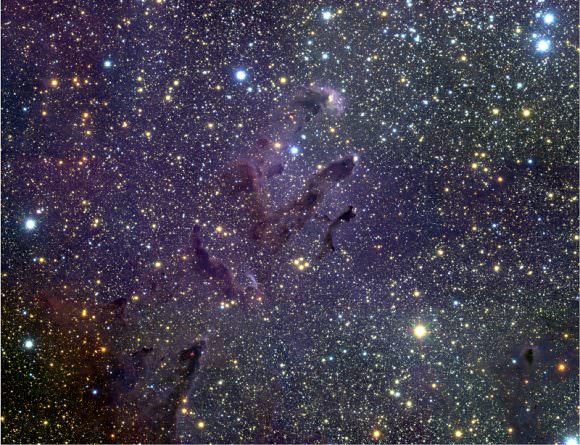
These pockets of interstellar gas are dense enough to collapse under their own weight, forming young stars that continue to grow as they accumulate more and more mass from their surroundings. As their place of birth contracts gravitationally, the interior gas reaches its end and the intense radiation of bright young stars causes low density material to boil away.
These regions were first photographed by the Hubble Space Telescope in 1995. As Jeff Hester – a professor at Arizona State University and an investigator with the Hubble’s Wide Field and Planetary Camera 2 (WFPC2) – said of the discovery:
“For a long time astronomers have speculated about what processes control the sizes of stars – about why stars are the sizes that they are. Now in M16 we seem to be watching at least one such process at work right in front of our eyes.”
The Hubble has shown us what happens when all the gas boils away and only the EGGs are left. “It’s a bit like a wind storm in the desert,” said Hester. “As the wind blows away the lighter sand, heavier rocks buried in the sand are uncovered. But in M16, instead of rocks, the ultraviolet light is uncovering the denser egg-like globules of gas that surround stars that were forming inside the gigantic gas columns.”
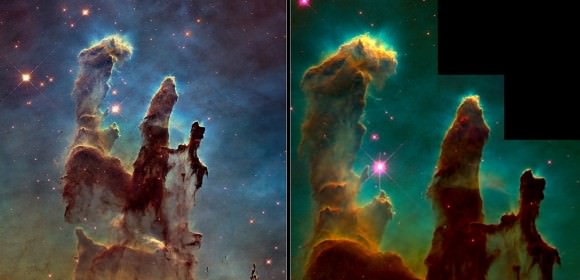
And some of these EGGs are nothing more than what would appear to be tiny bumps and teardrops in space – but at least we are looking back in time to see what stars look like when they were first born. “This is the first time that we have actually seen the process of forming stars being uncovered by photoevaporation,” Hester emphasized. “In some ways it seems more like archaeology than astronomy. The ultraviolet light from nearby stars does the digging for us, and we study what is unearthed.”
History of Observation:
The star cluster associated with M16 (NGC 6611) was first discovered by Philippe Loys de Chéseaux in 1745-6. However, it was Charles Messier who was the very first to see the nebulosity associated with it. As he recorded in his notes:
“In the same night of June 3 to 4, 1764, I have discovered a cluster of small stars, mixed with a faint light, near the tail of Serpens, at little distance from the parallel of the star Zeta of that constellation: this cluster may have 8 minutes of arc in extension: with a weak refractor, these stars appear in the form of a nebula; but when employing a good instrument one distinguishes these stars, and one remarks in addition a nebulosity which contains three of these stars. I have determined the position of the middle of this cluster; its right ascension was 271d 15′ 3″, and its declination 13d 51′ 44″ south.”
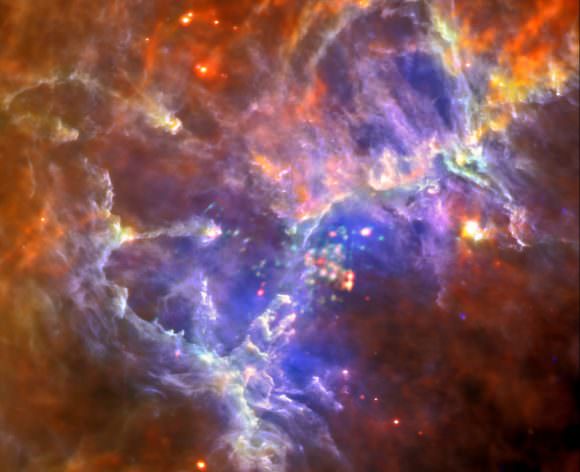
Oddly enough, Sir William Herschel, who was famous for elaborating on Messier’s observations, didn’t seem to notice the nebula at all (according to his notes). And Admiral Smyth, who could always be counted on for flowery prose about stellar objects, just barely saw it as well:
“A scattered but fine large stellar cluster, on the nombril of Sobieski’s shield, in the Galaxy, discovered by Messier in 1764, and registered as a mass of small stars in the midst of a faint light. As the stars are disposed in numerous pairs among the evanescent points of more minute components, it forms a very pretty object in a telescope of tolerable capacity.”
But of course, the nebula isn’t an easy object to spot and its visibility on any given night depends greatly on sky conditions. As historical evidence suggest, only one of the two masters (Messier) caught it. So take a lesson from history and return to the sky many times. One day you’ll be rewarded!
Locating Messier 16:
One of the easiest ways to find M16 is to identify the constellation of Aquila and begin tracing the stars down the eagle’s back to Lambda. When you reach that point, continue to extend the line through to Alpha Scuti, then southwards towards Gamma Scuti. Aim your binoculars or image correct finderscope at Gamma and put it in the 7:00 position.
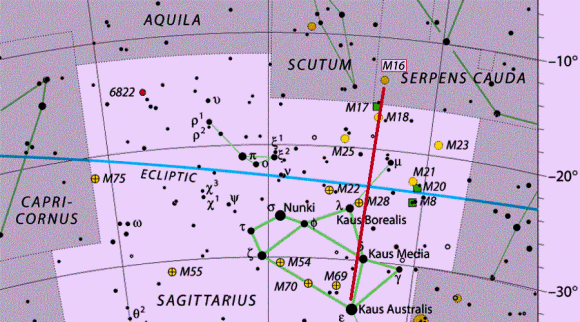
For those using a finderscope, M16 will easily show up as a faint haze. Even those using binoculars won’t miss it. If Gamma is in the lower left hand corner of your vision – then M16 is in the upper right hand. For all optics, you won’t be able to miss the open star cluster and the faint nebulosity of IC 4703 can be seen from dark sky locations.
Another way to find M16 is by first locating the “Teapot” asterism in Sagittarius constellation (see above), and then by following the line from the star Kaus Australis (Epsilon Sagittarii) – the brightest star in Sagittarius – to just east of Kaus Media (Delta Sagittarii). Another way to find the nebula is by extending a line from Lambda Scuti in Scutum constellation to Alpha Scuti, and then to the south to Gamma Scuti.
Those using large aperture telescopes will be able to see the nebula well, but sky conditions are everything when it comes to this one. The star cluster which is truly M16 will always be easy, but the nebula is a challenge.
And as always, here are the quick facts on M16 to help you get started:
Object Name: Messier 16
Alternative Designations: M16, NGC 6611, Eagle Nebula (IC 4703)
Object Type: Open Star Cluster and Emission Nebula
Constellation: Serpens (Cauda)
Right Ascension: 18 : 18.8 (h:m)
Declination: -13 : 47 (deg:m)
Distance: 7.0 (kly)
Visual Brightness: 6.4 (mag)
Apparent Dimension: 7.0 (arc min)
And be sure to enjoy this video of the Eagle Nebula and the amazing photographs of the “Pillar of Creation”:
We have written many interesting articles about Messier Objects here at Universe Today. Here’s Tammy Plotner’s Introduction to the Messier Objects, , M1 – The Crab Nebula, M8 – The Lagoon Nebula, and David Dickison’s articles on the 2013 and 2014 Messier Marathons.
Be to sure to check out our complete Messier Catalog. And for more information, check out the SEDS Messier Database.
How Far Back Are We Looking in Time?
When we look out into space, we’re also looking back into time. Just how far back can we see?
The Universe is a magic time window, allowing us to peer into the past. The further out we look, the further back in time we see. Despite our brains telling us things we see happen at the instant we view them, light moves at a mere 300,000 kilometers per second, which makes for a really weird time delay at great distances.
Let’s say that you’re talking with a friend who’s about a meter away. The light from your friend’s face took about 3.336 nanoseconds to reach you. You’re always seeing your loved ones 3.336 nanoseconds into the past. When you look around you, you’re not seeing the world as it is, you’re seeing the world as it was, a fraction of a second ago. And the further things are, the further back in time you’re looking.
The distance to the Moon is, on average, about 384,000 km. Light takes about 1.28 seconds to get from the Moon to the Earth. If there was a large explosion on the Moon of a secret Nazi base, you wouldn’t see it for just over a second. Even trying to communicate with someone on the Moon would be frustrating as you’d experience a delay each time you talked.
Let’s go with some larger examples. Our Sun is 8 minutes and 20 seconds away at the speed of light. You’re not seeing the Sun as it is, but how it looked more than 8 minutes ago.
On average, Mars is about 14 light minutes away from Earth. When we were watching live coverage of NASA’s Curiosity Rover landing on Mars, it wasn’t live. Curiosity landed minutes earlier, and we had to wait for the radio signals to reach us, since they travel at the speed of light.
When NASA’s New Horizons spacecraft reaches Pluto next year, it’ll be 4.6 light hours away. If we had a telescope strong enough to watch the close encounter, we’d be looking at events that happened 4.6 hours ago.
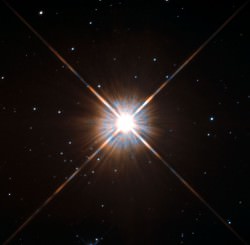
The closest star, Proxima Centauri, is more than 4.2 light-years away. This means that the Proxima Centurans don’t know who won the last US Election, or that there are going to be new Star Wars movies. They will, however, as of when this video was produced, be watching Toronto make some questionable life choices regarding its mayoral election.
The Eagle Nebula with the famous Pillars of Creation, is 7,000 light-years away. Astronomers believe that a supernova has already gone off in this region, blasting them away. Take a picture with a telescope and you’ll see them, but mostly likely they’ve been gone for thousands of years.
The core of our own Milky Way galaxy is about 25,000 light-years away. When you look at these beautiful pictures of the core of the Milky Way, you’re seeing light that may well have left before humans first settled in North America.
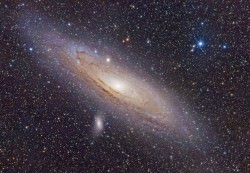
And don’t get me started on Andromeda. That galaxy is more than 2.5 million light-years away. That light left Andromeda before we had Homo Erectus on Earth. There are galaxies out there, where aliens with powerful enough telescopes could be watching dinosaurs roaming the Earth, right now.
Here’s where it gets even more interesting. Some of the brightest objects in the sky are quasars, actively feeding supermassive black holes at the cores of galaxies. The closest is 2.5 billion light years away, but there are many much further out. Earth formed only 4.5 billion years ago, so we can see quasars shining where the light had left before the Earth even formed.
The Cosmic Microwave Background Radiation, the very edge of the observable Universe is about 13.8 billion light-years away. This light left the Universe when it was only a few hundred thousand years old, and only now has finally reached us. What’s even stranger, the place that emitted that radiation is now 46 billion light-years away from us.
So crack out your sonic screwdrivers and enjoy your time machine, Whovians. Your ability to look out into space and peer into the past. Without a finite speed of light, we wouldn’t know as much about the Universe we live in and where we came from. What moment in history do you wish you could watch? Express your answer in the form of a distance in light-years.
Hubble Makes ‘Pillars Of Creation’ Look Better Than Ever
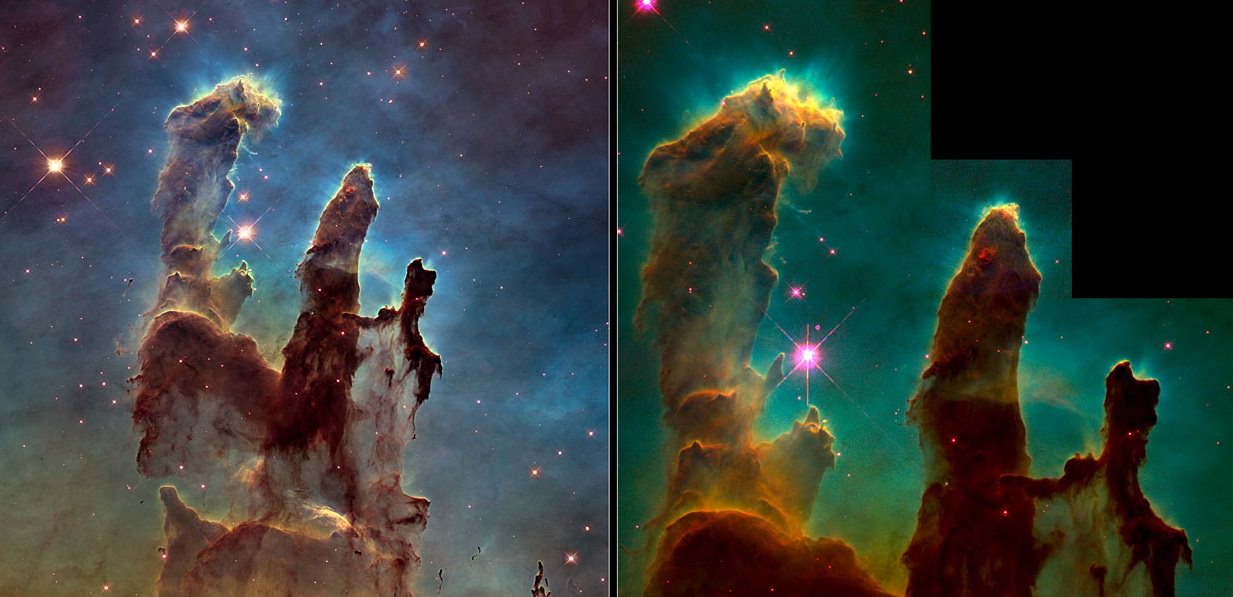
When you look at that image on the right, make sure to thank the STS-125 crew. And all the people who defended the idea of sending one last repair mission to the Hubble Space Telescope before the space shuttle was decommissioned.
That’s because the famous “Pillars of Creation” image taken in 1995 by Hubble just got a huge upgrade. Using a camera the astronauts installed in 2009, astronomers recently revisited the iconic image and got far more detail this time around. And please, do yourself a favor to click through and see the ethereal infrared image Hubble got at the same time.
Embedded in these Eagle Nebula towers, which are sometimes called elephant trunks, are stars under creation. And in a short span of 20 years, you can see how the stars are slowly blowing the pillars apart. This is leading some press officials to call the structures “pillars of destruction.” And astronomers can chart how everything is changing over time.
“I’m impressed by how transitory these structures are. They are actively being ablated away before our very eyes,” stated Paul Scowen of Arizona State University in Tempe, one of the astronomers who led the 1995 observations.
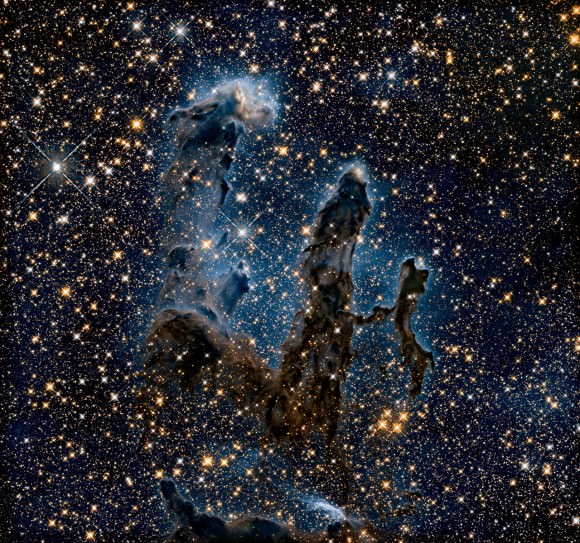
“These pillars represent a very dynamic, active process,” Scowen added. “The gas is not being passively heated up and gently wafting away into space. The gaseous pillars are actually getting ionized (a process by which electrons are stripped off of atoms) and heated up by radiation from the massive stars. And then they are being eroded by the stars’ strong winds (barrage of charged particles), which are sandblasting away the tops of these pillars.”
One large find from the two images showed a “narrow jet-like feature” that could have been emanating from a brand-new star. It’s been getting larger over the past two decades, moving more than 60 billion miles further into the universe.
The new images were presented at the American Astronomical Society meeting in Seattle this week.
Sources: Hubble European Space Agency Information Centre and Space Telescope Science Institute
The Making of the Pillars of Creation
It’s one of the most iconic images of the modern Space Age. In 1995, the Hubble Space Telescope team released an image of towering columns of gas and dust that contained newborn stars in the midst of formation. Dubbed the “Pillars of Creation,” these light-years long tendrils captivated the public imagination and now grace everything from screensavers to coffee mugs. This is a cosmic portrait of our possible past, and the essence of the universe giving birth to new stars and worlds in action.
Now, a study out on Thursday from the 2014 National Astronomy Meeting of the Royal Astronomical Society has shed new light on just how these pillars may have formed. The announcement comes out of Cardiff University, where astronomer Scott Balfour has run computer simulations that closely model the evolution and the outcome of what’s been observed by the Hubble Space Telescope.
The ‘Pillars’ lie in the Eagle Nebula, also known as Messier 16 (M16), which is situated in the constellation Serpens about 7,000 light years distant. The pillars themselves have formed as intense radiation from young massive stars just beginning to shine erode and sculpt the immense columns.
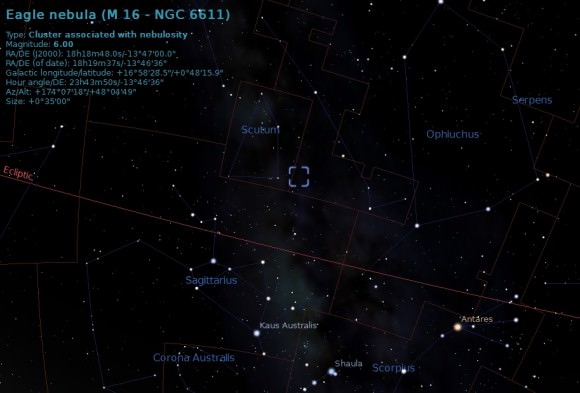
But as is often the case in early stellar evolution, having massive siblings nearby is bad news for fledgling stars. Such large stars are of the O-type variety, and are more than 16 times as massive as our own Sun. Alnitak in Orion’s belt and the stars of the Trapezium in the Orion Nebula are examples of large O-type stars that can be found in the night sky. But such stars have a “burn fast and die young” credo when it comes to their take on nuclear fusion, spending mere millions of years along the Main Sequence of the Hertzsprung Russell diagram before promptly going supernova. Contrast this with a main sequence life expectancy of 10 billion years for our Sun, and life spans measured in the trillions of years — longer than the current age of the universe — for tiny red dwarf stars. The larger a star you are, the shorter your life span.
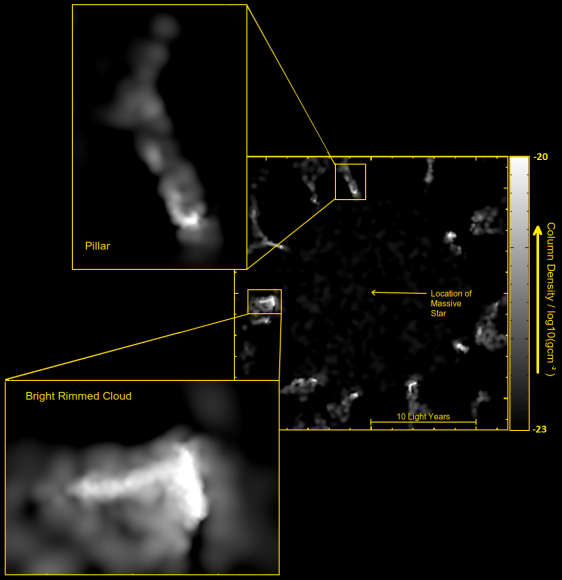
Such O-Type stars also have surface temperatures at a scorching 30,000 degrees Celsius, contrasted with a relatively ‘chilly’ 5,500 degree Celsius surface temperature for our Sun.
This also results in a prodigious output in energetic ultraviolet radiation by O-type stars, along with a blustery solar wind. This carves out massive bubbles in a typical stellar nursery, and while it may be bad news for planets and stars attempting to form nearby any such tempestuous stars, this wind can also compress and energize colder regions of gas and dust farther out and serve to trigger another round of star formation. Ironically, such stars are thus “cradle robbers” when it comes to potential stellar and planetary formation AND promoters of new star birth.
In his study, Scott looked at the way gas and dust would form in a typical proto-solar nebula over the span of 1.6 million years. Running the simulation over the span of several weeks, the model started with a massive O-type star that formed out of an initial collapsing smooth cloud of gas.
That’s not bad, a simulation where 1 week equals a few hundred million years…
As expected, said massive star did indeed carve out a spherical bubble given the initial conditions. But Scott also found something special: the interactions of the stellar winds with the local gas was much more complex than anticipated, with three basic results: either the bubble continued to expand unimpeded, the front would expand, contract slightly and then become a stationary barrier, or finally, it would expand and then eventually collapse back in on itself back to the source.
The study was notable because it’s only in the second circumstance that the situation is favorable for a new round of star formation that is seen in the Pillars of Creation.
“If I’m right, it means that O-type and other massive stars play a much more complex role than we previously thought in nursing a new generation of stellar siblings to life,” Scott said in a recent press release. “The model neatly produces exactly the same kind of structures seen by astronomers in the classic 1995 image, vindicating the idea that giant O-type stars have a major effect in sculpting their surroundings.”
Such visions as the Pillars of Creation give us a snapshot of a specific stage in stellar evolution and give us a chance to study what we may have looked like, just over four billion years ago. And as simulations such as those announced in this week’s study become more refined, we’ll be able to use them as a predictor and offer a prognosis for a prospective stellar nebula and gain further insight into the secret early lives of stars.
‘Elephant Trunks’ Crowd Distant Star Cluster, Raising New Questions About Stellar Formation
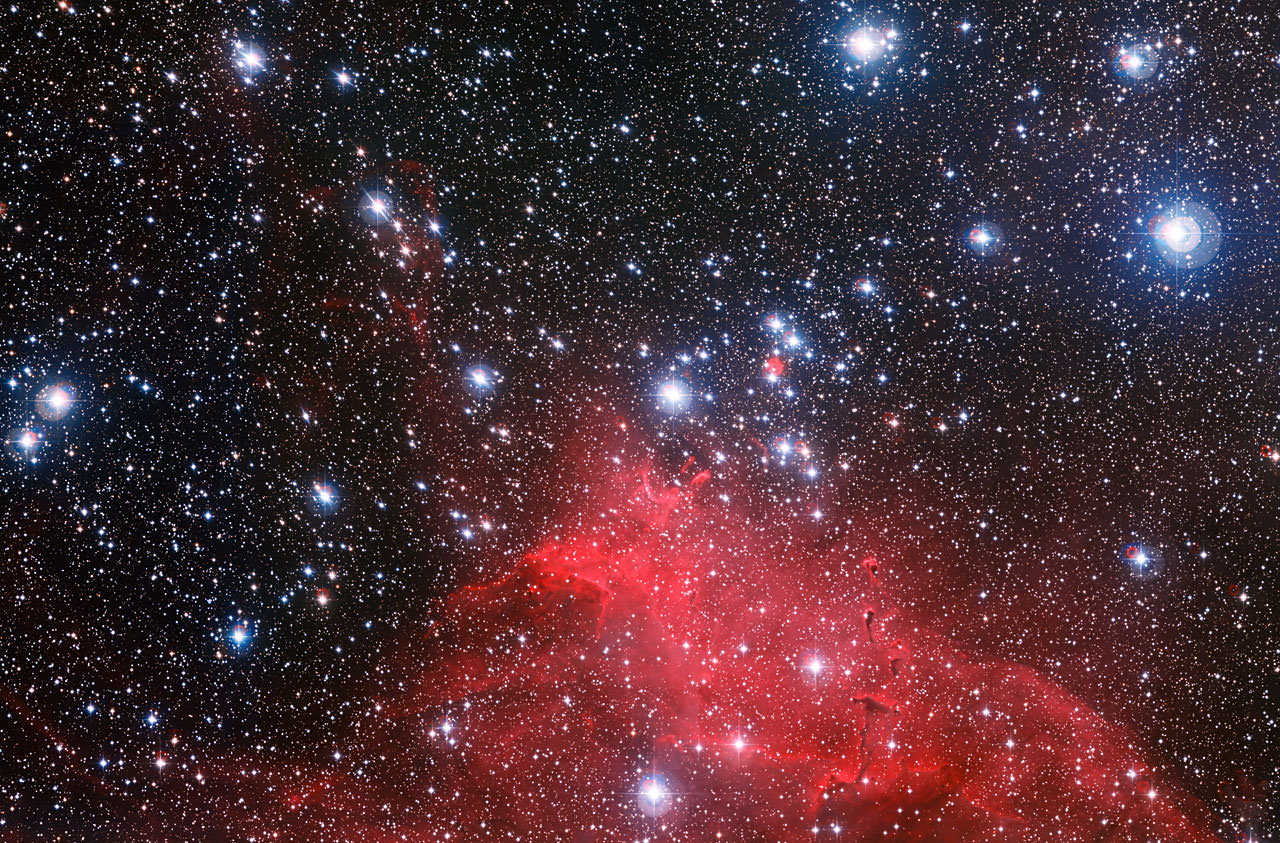
Star winds are pushing the gas around NGC 3572 into “elephant trunks”, as you can see if you look carefully as this picture snapped by a La Silla Observatory telescope at the European Southern Observatory in Chile. It’s a demonstration of the power of the youngster blue-white stars embedded in the cloud, which are generating huge gusts blowing the gas and dust away from them.
It’s common for young stars to form in groups. After a few million years growing together, their respective gravities pushes everything further apart, and the stars then finish their lifetimes on their own. Looking at young star clusters such as this gives astronomers a better sense about how our own Sun began its life.
If we zoomed closer to those elephant trunks, they would look similar to the famous “Pillars of Creation” image captured in 1995 by the Hubble Space Telescope in the Eagle Nebula (M16). NASA also did a follow-up observation using infrared wavelengths in 2005 and 2011, which made the young stars a bit easier to see amid the gas and dust.
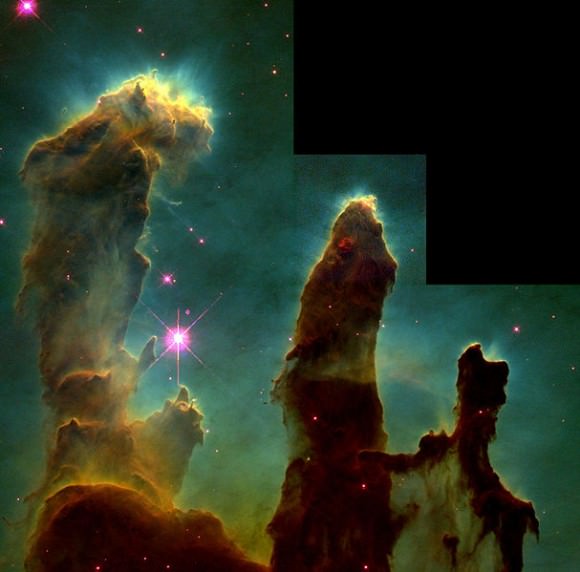
As for the picture of NGC 3572, the high-resolution image from the Wide Field Imager on the MPG/ESO 2.2-metre telescope is also revealing new mysteries that will require further investigation, ESO stated.
“A strange feature captured in this image is the tiny ring-like nebula located slightly above the centre of the image,” ESO wrote. “Astronomers still are a little uncertain about the origin of this curious feature. It is probably a dense leftover from the molecular cloud that formed the cluster, perhaps a bubble created around a very bright hot star. But some authors have considered that it may be some kind of oddly shaped planetary nebula — the remnants of a dying star.”
Astronomers were also surprised by seeing stars older than 10 million years old within this image that were still picking up mass, which implies that planetary formation could take longer than previously believed.
Research was led by ESO astronomer Giacomo Beccari.
Source: European Southern Observatory



